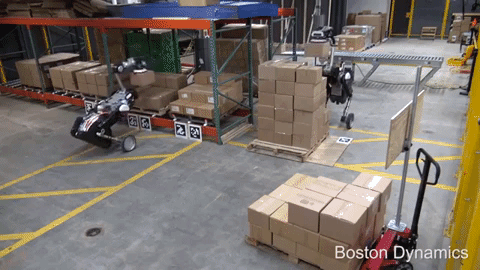Boston Dynamics deputed Handle two years back. Since then, however, the bipedal wheeled robot has taken a backseat to the rest of the company’s offering. While the ‘bot is no less impressive than the rest of its lineup, Boston Dynamics’ video output has almost exclusively been dedicated to Atlas and Spot/Spot Mini.
Today, however, the robot gets a bit more time to shine — albeit in slightly less glamorous circumstances. A new video offers a better look at the robot’s cargo carrying abilities, this time in a warehouse setting. The initial video showed how the robot was capable of picking up 100 pound crates, and now we’re seeing what it might look like the put the robot to work.
The “reimagined” version of the robot has some clear differences from its predecessor. It appears to be larger and, more strikingly, its twin arms have been replaced by a large, overhead suction cup gripper. This time out, lifts are limited to 30 pounds, though the boxes in the video weigh around 12. Even so, the dexterity, reach and balance of the robots deployed in the video are quite impressive at first glance.
According to the company, “Handle autonomously performs mixed SKU pallet building and depalletizing after initialization and localizing against the pallets. The on-board vision system on Handle tracks the marked pallets for navigation and finds individual boxes for grasping and placing.”
Last year at our Berkeley Robotics event, the company announced plans to commercialize Spot Mini. The robot is set for sale later this year, and is part of a new found focus on product monetization that appears to have been been a part of becoming part of a larger organization — first Google, then Softbank.

Of course, this video shouldn’t be taken a definitely sign that the company is moving in that direction, and besides, it’s hard to imagine a robot as advanced as handle not being prohibitively expensive for most warehouse. Still, at a time when most warehouse robots are essentially autonomous carts, there’s something to be said for a fast moving robot capable of actually picking products off of shelves.
from TechCrunch https://ift.tt/2HX8JAI
via IFTTT
Comments
Post a Comment